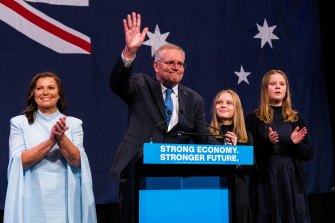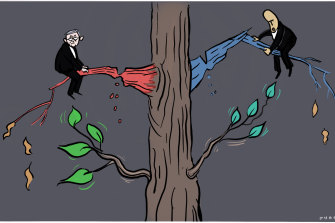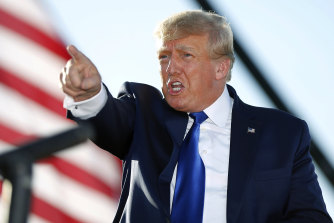Opinion
There are no natural majorities anymore. Albanese’s might be the last one
Waleed Aly
Columnist, co-host of Ten's The Project and academicAnd so, one of the least inspired election campaigns in Australian history has delivered us to one of its most fascinating political moments.
This week, Labor finally claimed a majority with its lowest primary vote this side of World War II. The Coalition has suffered the worst defeat I’ve ever seen, not in numbers of seats, but in their kind: it has a Liberal party with no liberal seats, and is therefore not so much wounded as dismembered – a bird with one wing. Meanwhile, the Greens march to third-party status, snatching seats off both major parties. This isn’t hype, it’s seismic. The very structure of Australian politics might be being remade.

Former prime minister Scott Morrison conceding defeat on election night.Credit:James Brickwood
To see this, consider the trends that are more coherent and durable than the apparently patchwork, chaotic results of one election.
For instance, progressive politics is becoming increasingly a politics of the rich. The Coalition suffered swings against it in all our highest-income, most-educated seats. But this is unlikely to be about the discrete issues of the last three years because the Coalition suffered adverse swings in those seats at the last election, too. Those swings mostly didn’t result in losses, but they made this year’s defeats much more possible.
It wasn’t just about the teals, either: the Coalition also surrendered these seats variously to Labor and the Greens. The Greens have wound up with four seats, three of which are made up of wealthy people and upwardly mobile students. The irony of this result is that despite progressive politics’ rhetorical tendency to rail against the privilege of rich white people, it is precisely these people who delivered this result.

The election results have revealed a realignment of support for the major parties.Credit:Andrew Dyson
Conversely, conservative politics becomes the politics of the struggling. Note, amidst the carnage, where the Coalition continues to gain ground. Seats with the highest levels of mortgage stress swung to the Coalition. So, too, did the most economically-disadvantaged seats in the country. The exception is in Queensland – hardly surprising given the Coalition maxed out its vote there in 2019. Meanwhile, Labor suffered consistent primary-vote swings against it in its safe suburban seats. So, now we have the new Opposition leader making a specific pitch for the suburbs and attacking big business. Once upon a time that would surely have been a Labor leader.
This remarkable realignment isn’t a fad. We’re seeing a version of it in Britain where Labour’s working class former strongholds are voting Brexit and Tory, and we’ve seen it writ large in America where the Republicans are losing wealthy urban voters and picking up poorer rural ones.
Donald Trump’s anti-elite rhetoric would once have been a Democrat’s. This turn has been building ever since the Cold War ended and Labo(u)r parties became advocates of the global free market: Tony Blair’s New Labour in the UK, Hawke and Keating here.
That helped transform Western democracies like ours from manufacturing economies to knowledge economies. Accordingly, there is now a much stronger correlation between income and tertiary education, and that has bitten especially hard in the US. The people who have cultural power and the likelihood of economic power are the knowledge class.

Trump’s anti-elite rhetoric would once have been a Democrat’s.Credit:AP
Our major parties were not built for this. They reflect a different political age of labour versus capital. Of course, hip-pocket voters still exist in large numbers, but they’re different now: aspirational rather than collectivist, so they vote for things like tax cuts even when they may not immediately enjoy the bulk of their fruits. The Coalition has understood this for decades, which explains how it has taken so many of them from Labor, even if still not a majority. Labor had to suffer defeat in 2019 with a redistributive agenda to grasp it finally, but it continues to shed them.
But these voters, split between the major parties, are insufficient to deliver government. Both parties, therefore try to retain them while appealing to the knowledge class. Accordingly, both parties are now built on a contradiction. Labor faced this first when it found itself wedged on issues like climate change and asylum seeker policy. The more it sought a position that appealed to the highly educated, the more it alienated its suburban base. It has leaked to the Coalition and the Greens for years.
But the Coalition has embodied a severe contradiction, too, between those who embrace a globalised free market with all the liberal and multicultural change that implies, and those attracted to a more nationalistic posture. John Howard’s liberal economics and cultural conservatism held this together, but it has been slowly unwinding ever since. At this year’s election, the tension finally snapped. There’s no guarantee the bond can be repaired.
Our major parties’ primary votes are in structural decline, not because they are simply hopeless, but because our politics has fragmented to the point there are no natural majorities in Australia anymore. We now have majorities of dissent – so we can remove a government via a coalition of discontent, but any new government becomes vulnerable to a new dissenting majority forming around it. Our tradition of compulsory preferential voting has camouflaged this, artificially preserving two-party dominance. If we had a more European-style proportional system, we’d have had European-style results for a decade now: moving from one minority government to another, each made up of a temporary coalition of rivals. This might be the moment that our political fracturing finally overpowered the masking tape of our electoral system.
Perhaps Labor, facing a maimed Coalition will find being a minimally decent and competent government enough to return with a bigger majority. But it’s equally possible our political fracturing continues apace and this is one of the last majority governments we have.
The Greens move from four seats to six, then to eight, and the Labor government ends its time in a formal coalition with a couple of Greens ministers. The Greens, having then become a party of government risk becoming like the UK’s Liberal Democrats, face a protest vote, and the whole thing gives way to a new conservative coalition of Liberals, Nationals, teals, One Nation, or whatever new parties have arisen in the meantime.
Unforeseen events (or, say, a recession) will probably decide that. Clearly though, what we’ve seen this year isn’t some spectacular accident. It is the culmination of things, of an Australia remade and a political system creaking under that strain. The next decade is about how long and loud those creaks will be.
The Morning Edition newsletter is our guide to the day’s most important and interesting stories, analysis and insights. Sign up here.